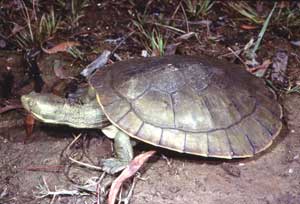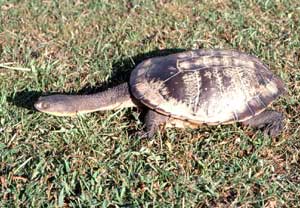Taxon Attribute Profiles

Macquarie Turtle Emydura macquarii
(photo: John Wombey)
|
Chelidae
freshwater turtles
Taxonomy and Ecology
Synopsis of included taxa
The family Chelidae is endemic to Australia, New Guinea, and South America
and consists of some 40 species of freshwater turtle. Twenty-four described
species are found in Australia and three of these occur in the Murray
Darling Basin: Chelodina expansa (Broad-shelled Turtle), Chelodina
longicollis (Snake-necked Turtle), and Emydura macquarii (Macquarie
Turtle). These are "side-necked" turtles, so named because the
neck and head, when not extended, fold under the leading edge of the carapace,
and they are further characterised by their relatively flattened shells
and their clawed webbed feet (Wilson and Swan 2003).
Life Form/Morphology

Snake-necked Turtle Chelodina longicollis
(photo: John Wombey)
|
Turtles of the genus Chelodina are distinguished by their exceptionally
long necks. C. expansa is the largest of Australia’s freshwater
turtles: its carapace (upper shell) measures up to 48 cm in length and
its long thick neck, when outstretched, adds another 80% to its overall
body length. C. longicollis is a medium-sized turtle, its carapace
measuring up to 25 cm in length, with a long slender neck. Apart from
size, adults of the two species are differentiated by the white iris,
neck tubercles, and broad black sutures on the plastron (lower shell)
of C. longicollis. The light olive to dark brown carapace of C.
expansa also averages lighter in colour than that of C. longicollis,
which is dark brown to black, and the plastron of the juvenile C. longicollis
is distinctively marked with black and red-orange (Cann 1998).
Emydura species have much shorter necks than those of Chelodina.
E. macquarii is a brown turtle with a pale yellow or cream stripe
extending from the mouth back along the neck. The nominate race, which
inhabits the Murray Darling Basin, is large (carapace length to 34 cm)
and has a distinctive yellow iris.
 Distribution Distribution
C. expansa, C. longicollis, and E. macquarii are
restricted to eastern Australia and are widespread in the Murray Darling
Basin. The ranges of C. expansa and C. longicollis extend
additionally to the southeast Queensland coast, C. expansa north
to Rockhampton and offshore to Fraser Island and C. longicollis
north to the Townsville region. C. longicollis is also widespread
in coastal drainages of New South Wales and Victoria. The subspecies E.
m. macquarii is endemic to the Murray Darling Basin; other races of
this species are found in coastal New South Wales and southeast Queensland.
Habitat
C. expansa is typically found in turbid water at the bottom of
rivers and permanent streams and waterholes, lying concealed among debris
or among root-mats. C. longicollis prefers swamps, oxbow lakes,
billabongs, and slow-moving weedy rivers and streams, but can also occur
in swift-flowing watercourses and can be found dispersing overland. E.
macquarii occurs along rivers, creeks and lagoons, often in larger
rivers and large waterholes; it is frequently seen basking on emergent
logs or rocks.
Role in Community
Roles in the community differ substantially among the three species:
C. expansa is a specialised predator, C. longicollis an
opportunistic carnivore, and E. macquarii an opportunistic omnivore.
C. expansa uses ambush tactics on highly mobile prey, its neck
striking out like a snake. Most commonly eaten prey items are decapod
crustaceans (notably crayfish and prawns), aquatic insects (Hemiptera),
and small fish (Chessman 1983). C. longicollis feeds primarily
on planktonic crustaceans (mostly Cladocera), fish carrion, prawns, corixids
(Hemiptera), chironomids (Diptera), and small fish, and its diet varies
depending on the type of water body occupied (Chessman 1984). E. macquarii
has an extremely varied diet, consisting largely of filamentous algae,
vertebrate carrion, detritus, periphyton, aquatic insects, and aquatic
plants (Chessman 1986). However, carrion and invertebrates appear to be
essential dietary items for this species, owing to its inability to meet
its metabolic requirements solely from macrophytes (Spencer et al. 1998).
Reproduction and Establishment
Reproduction
Little is known about courtship and mating of turtles in the Murray Darling
Basin, although mating of C. longicollis has been observed in April-May
and September-October and in captivity in January. Mating of E. macquarii
in captivity has been observed in January and in March-April (Cann 1998).
When ready to nest, females leave the water to excavate a nest hole, lay
their eggs, bury the nest, and return to the water, leaving the eggs to
incubate on their own. Nest-site selection in at least one species (E.
macquarii) – and probably others – is a trade-off between
minimising predation on the laying female, which increases further from
shore, and nest predation, which increases closer to shore (Spencer and
Thompson 2003). C. expansa nests mainly March-May, C. longicollis
September-December, and E. macquarii November-December, although
nesting can occur at other times of the year, especially following substantial
rains (Cann 1998). Nests of these species are generally close to water,
but can be up to 1 km distant. From 5-30 eggs are laid (typically 10-15)
and natural incubation periods range from 65-85 days in E. macquarii
and 120-180 days in C. longicollis to some 200-650 days in C.
expansa (Goode and Russell 1968; Cann 1998). Sex determination in
at least two of these species (C. longicollis and E. macquarii)
is not dependent on temperature (Georges 1988).
Dispersability
Terrestrial movements are important features in the life histories of
freshwater turtles; movements may be necessitated by such factors as habitat
loss, food shortage, and rainfall events (Graham et al. 1996). Movements
of C. longicollis are well documented: this species is often found
a considerable distance from water and has been shown to possess navigational
abilities. Non-nesting movements of C. expansa and E. macquarii
are not as well known, although they likely occur occasionally in response
to climatic factors.
Juvenile Period
Male E. macquarii and C. expansa mature at 5-6 years and
9-11 years, respectively, and females at 9-11 years and 14-15 years, respectively.
Young E. macquarii exhibit rapid juvenile growth followed by a
decline in growth rate towards maturity, whereas young C. expansa
grow more slowly during their first 3-4 years (Spencer 2002).
Hydrology and Salinity
Flooding Regimes
Alternating periods of flooding and drought could affect freshwater turtles,
owing to the limited dispersal ability of some species.
Conservation Status
Although C. longicollis is considered of least concern, C.
expansa and E. macquarii are presumed threatened but are too
rare or insufficiently known for conservation status to be assessed accurately
(Cogger 1993). Freshwater turtles are vulnerable to many human and natural
factors. For example, large numbers of these turtles are accidentally
caught and drowned in drum-nets and they are quite vulnerable to changes
in water levels brought on by drought and human water-use. Chelids occasionally
succumb to unknown pressures: several hundred E. macquarii, for
instance, were unaccountably found dead at Lake Boga, South Australia,
during the first half of 1976, while many others were clearly emaciated
(Cann 1998). Predators are also a threat to freshwater turtles of the
Murray Darling Basin, especially to nests and hatchlings. A study of nesting
along the Murray found that 96% of nests of C. expansa, C. longicollis,
and E. macquarii had been depredated, mainly by foxes but also
by water-rats, goannas, and ravens (Thompson 1983).
Uses
Freshwater turtles are collected and eaten by aboriginal people and Europeans
in many regions of Australia, and large numbers are known to be taken
in parts of New South Wales (Cann 1998).
Summary
Chelid turtles of the Murray Darling Basin form a suite of three co-existing
species of differing diet and habitat preferences. Changes in abundance
of these species may serve as useful indicators of the abundance of their
respective prey items and of waterway health generally.
References
Cann, J. 1998. Australian freshwater turtles. Beaumont Publ.,
Singapore.
Chessman, B. C. 1983. Observations on the diet of the broad-shelled turtle,
Chelodina expansa Gray (Testudines: Chelidae). Australian Wildlife
Research 10:169-172.
Chessman, B. C. 1984. Food of the snake-necked turtle, Chelodina longicollis
(Shaw) (Testudines: Chelidae) in the Murray Valley, Victoria and New South
Wales. Australian Wildlife Research 11:573-578.
Chessman, B. C. 1986. Diet of the Murray turtle, Emydura macquarii
(Gray) (Testudines: Chelidae). Australian Wildlife Research 13:65-69.
Cogger, H. G., Cameron, E. E., Sadlier, R. A., and P. Eggler. 1993. The
action plan for Australian reptiles. Australian Nature Conservation
Agency, Canberra.
Georges, A. 1988. Sex determination is independent of incubation temperature
in another chelid turtle, Chelodina longicollis. Copeia
1988:249-255.
Goode, J, and J. Russell. 1968. Incubation of eggs of three species of
chelid tortoises, and notes on their embryological development. Australian
Journal of Zoology 16:749-761.
Graham, T., Georges, A., and N. McElhinney. 1996. Terrestrial orientation
by the Eastern Long-necked Turtle, Chelodina longicollis, from
Australia. Journal of Herpetology 30:467-477.
Spencer, R. 2002. Growth patterns of two widely distributed freshwater
turtles and a comparison of common methods used to estimate age. Australian
Journal of Zoology 50:477-490.
Spencer, R., Thompson, M. B., and I. D. Hume. 1998. The diet and digestive
energetics of an Australian short-necked turtle, Emydura macquarii.
Comparative Biochemistry and Physiology Part A 121:341-349.
Spencer, R., and M. B. Thompson. 2003. The significance of predation
in nest site selection of turtles: an experimental consideration of macro-
and microhabitat preferences. Oikos 102:592-600.
Thompson, M. B. 1983. Population of the Murray River tortoise Emydura
(Chelidae): the effect of egg predation by the red fox, Vulpes vulpes.
Australian Wildlife Research 10:363-371.
Wilson, S. and G. Swan. 2003. A complete guide to the reptiles of
Australia. New Holland Publ., Sydney.
|

